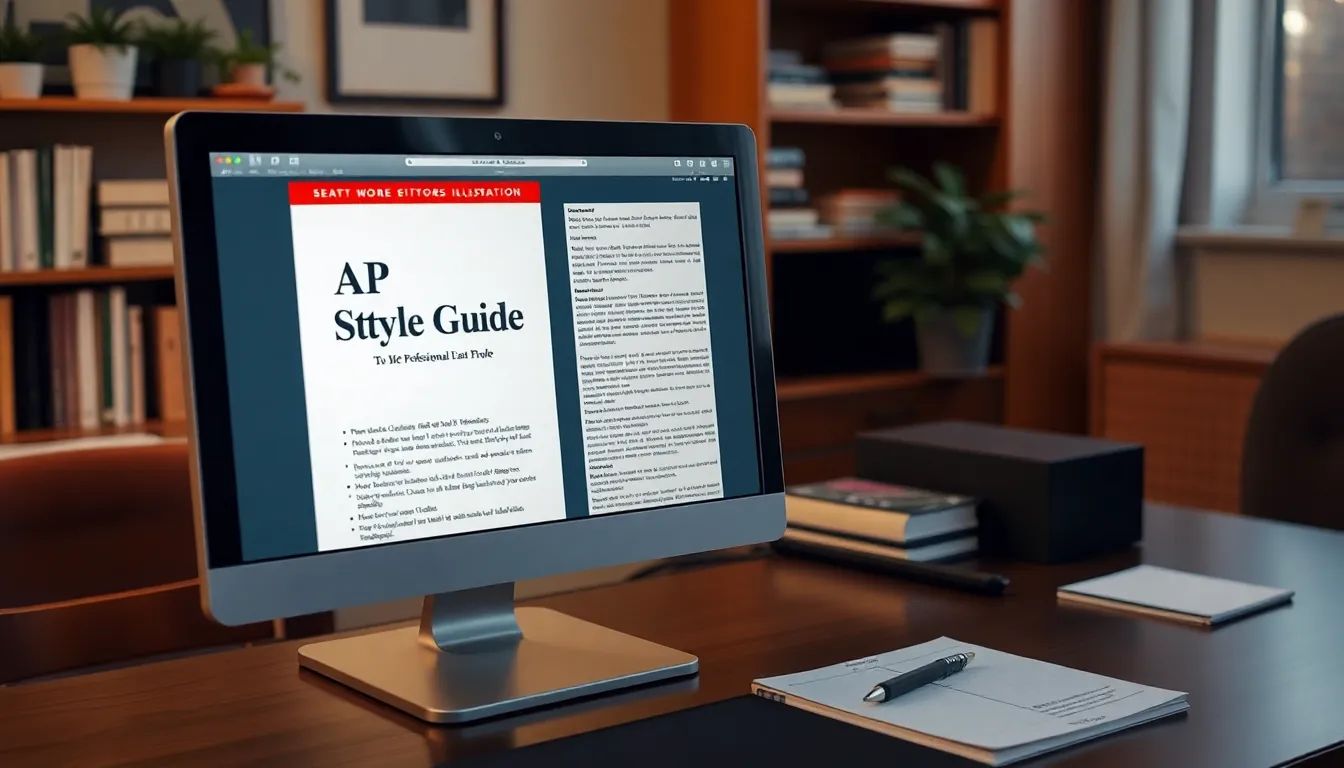Navigating the world of writing can feel like trying to find your way out of a maze—especially when it comes to style guides. Enter the AP Style Guide PDF, the trusty map for journalists, bloggers, and anyone who wants to sound like they know what they’re doing. With its clear rules and quirky guidelines, it’s like having a grammar guru in your back pocket ready to rescue you from the clutches of misplaced commas and confusing hyphens.
Table of Contents
ToggleUnderstanding AP Style Guide
The AP Style Guide serves as a crucial resource for writers, especially journalists and bloggers. Clarity and precision in writing thrive under its structured rules.
What Is the AP Style Guide?
The AP Style Guide outlines standardized writing conventions. It includes guidelines on punctuation, capitalization, abbreviation, and source attribution. Widely used in newsrooms, the guide ensures consistency and readability across various media platforms. Resources like this are invaluable for maintaining professional communication, especially in journalism.
Importance of Consistency in Writing
Consistency in writing fosters clarity and trust among readers. Adhering to the AP Style enhances credibility, making texts easier to read. Consistent formatting eliminates confusion over terms and punctuation. Journalists particularly benefit, as loyal audiences rely on clear reporting. Style uniformity also streamlines editorial processes, allowing faster content production.
Accessing the AP Style Guide PDF


Accessing the AP Style Guide PDF is straightforward and accessible for anyone seeking to improve their writing standards. Writers can refer to several reliable sources to locate this essential guide.
Where to Find the PDF
The AP Style Guide PDF is available on the official Associated Press website, which ensures the most accurate and up-to-date information. Many libraries also offer digital or print versions of the guide for public use. Educational institutions frequently provide access through their online resources, making it easy for students and faculty to utilize the guide for academic purposes. Additionally, trusted online bookstores often sell PDF versions, providing yet another avenue for access.
Downloading and Printing Options
Downloading the AP Style Guide PDF involves navigating to the authorized website or ebook retailer. Users typically find a straightforward download process, often requiring a simple click on the download button. After downloading, printing options cater to various preferences, allowing users to print specific sections or the entire guide. To ensure clarity and readability, it’s beneficial to select appropriate paper sizes and settings during printing, which enhances usability for reference while writing.
Key Features of the AP Style Guide
The AP Style Guide encompasses essential rules and guidelines that enhance writing clarity and consistency.
Grammar and Punctuation Rules
Grammar guidelines establish a foundation for clear communication. They specify correct subject-verb agreement and verb tense usage. Punctuation rules dictate the correct use of commas, periods, and quotation marks in various contexts. Specific examples illustrate when to use semicolons versus conjunctions. These rules help avoid common pitfalls, such as misplaced punctuation, ensuring that readers easily grasp the intended message.
Formatting Guidelines
Formatting guidelines dictate how to present various types of content effectively. They include capitalization rules for titles, names, and organizations. The guide details how to format lists and bullet points for readability. Numbers often require specific formatting—e.g., writing out numbers under ten while using numerals for ten and above. These guidelines ensure uniformity across articles, enhancing aesthetic appeal and facilitating easier navigation for readers.
Common Mistakes in AP Style
Writers often encounter common pitfalls when following the AP Style Guide. These mistakes can impact the clarity and professionalism of their writing.
Misused Commas and Periods
Writers commonly struggle with comma placement. Misplaced commas can change the meaning of a sentence. For instance, use commas to separate items in a series and after introductory phrases. Periods should end complete thoughts instead of being misused within complex sentences. Writers may place a period where a comma is necessary, leading to fragmented statements. Adhering to the AP rules on punctuation helps enhance the flow of sentences. Moreover, understanding where to use periods, particularly in lists or compound sentences, ensures clarity in communication.
Incorrect Capitalization Practices
Capitalization errors frequently occur in titles and names. Writers may capitalize unnecessary words or neglect to capitalize proper nouns. According to AP Style, capitalize only the first word of titles and subtitles, along with proper nouns. For example, “The Quick Brown Fox Jumps Over the Lazy Dog” should read “The quick brown fox jumps over the lazy dog.” Additionally, writers might misunderstand capitalization for organizations or job titles. Correctly applying capitalization rules fosters professionalism and consistent tone in written works. Following these guidelines prevents confusion among readers and maintains authority in writing.
The AP Style Guide PDF is an invaluable tool for anyone involved in writing. It not only streamlines the writing process but also elevates the quality of communication. By following its guidelines, writers can ensure their work remains clear and professional. Accessing the guide is simple and offers a wealth of knowledge that can significantly improve writing skills. Embracing the AP Style Guide fosters consistency and enhances credibility, making it a must-have resource for journalists and bloggers alike. With this guide in hand, writers can confidently navigate the complexities of style and punctuation, ultimately delivering polished and engaging content.





